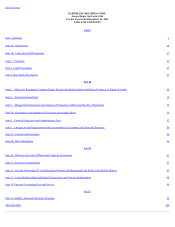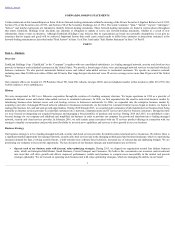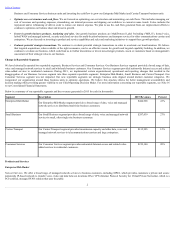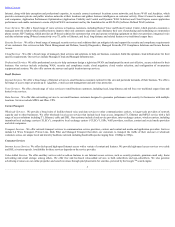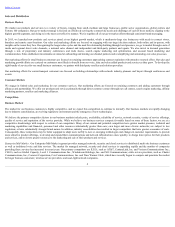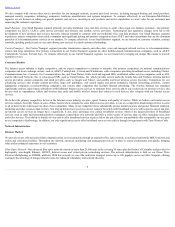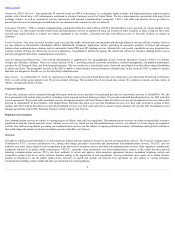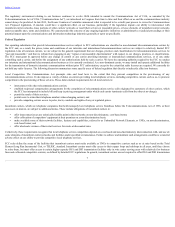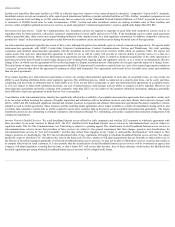Earthlink 2015 Annual Report Download - page 8
Download and view the complete annual report
Please find page 8 of the 2015 Earthlink annual report below. You can navigate through the pages in the report by either clicking on the pages listed below, or by using the keyword search tool below to find specific information within the annual report.
Table of Contents
We also compete with various other service providers for our managed network, security and cloud services, including managed hosting and cloud providers,
managed security companies, technology companies, hardware manufacturers and systems integrators. To compete effectively in our Enterprise/Mid-Market
segment, we are focused on selling our growth products and services, investing in new products and service capabilities to create value for our customers and
improving the customer experience.
Small Business . Our Small Business segment primarily provides traditional voice and data services to small, often single site business customers. Our primary
competitors are ILECs, CLECs, cable service providers and wireless and satellite service providers. Technological and regulatory changes have led to the
development of new products and services that have reduced demand or compete with our traditional voice and data products. Our Small Business segment
experiences intense competition from cable companies and significant pricing and product competition from AT&T and other incumbents that are the dominant
providers of telecommunications services in our markets. To compete effectively in our Small Business segment, we are focused on customer retention, contract
renewals, upselling products and services and offering new services to extend customer relationships.
Carrier/Transport . Our Carrier/Transport segment provides transmission capacity and other data, voice and managed network services to telecommunications
carriers and large enterprises. Our primary competitors in our Carrier/Transport segment are other facilities-based communications companies, such as AT&T,
CenturyLink, Verizon, XO and Zayo. To compete effectively in our Carrier/Transport segment, we are focused on leveraging our unique fiber assets to provide
transport services.
Consumer Markets
The Internet access industry is highly competitive, and we expect competition to continue to intensify. Our primary competitors are national communications
companies and local exchange carriers, such as AT&T, CenturyLink , Verizon and Windstream; cable companies providing broadband access, including Charter
Communications, Inc., Comcast, Cox Communications, Inc. and Time Warner Cable; local and regional ISPs; established online services companies, such as AOL
and the Microsoft Network; free or value-priced ISPs, such as United Online, Inc. which provides service under the brands Juno and NetZero; wireless Internet
service providers; content companies and email providers, such as Google and Yahoo!; and satellite and fixed wireless service providers. Competitors for our
advertising services also include content providers, large web publishers, web search engine and portal companies, Internet advertising providers, content
aggregation companies, social-networking companies, and various other companies that facilitate Internet advertising. The wireless business has expanded
significantly and has caused many subscribers with traditional Internet access services to terminate those services and to rely exclusively on wireless services, and
devices such as smartphones, tablets and wireless data cards and mobile wireless routers that connect to such devices, also compete with our Internet access
services.
We believe the primary competitive factors in the Internet access industry are price, speed, features and quality of service. While we believe our Internet access
services compete favorably based on some of these factors when compared to some Internet access providers, we are at a competitive disadvantage relative to some
or all of these factors with respect to other of our competitors. Many of our competitors have substantially greater market presence and greater financial, technical,
marketing and other resources than we have. Our dial-up Internet access services do not compete favorably with broadband services with respect to speed, and dial-
up Internet access services no longer have a significant, if any, price advantage over certain broadband services. Most of the largest providers of broadband
services, such as cable and telecommunications companies, control their own networks and offer a wider variety of services than we offer, including voice, data
and video services. Their ability to bundle services and to offer broadband services at prices below the price that we can profitably offer comparable services puts
us at a competitive disadvantage. In addition, our only significant access to offer broadband services over cable is through our agreement with Time Warner Cable.
Network Infrastructure
Business Markets
We provide secure, efficient and reliable communications services primarily through an expansive fiber optic network, an advanced nationwide MPLS network and
switch and colocation facilities. Throughout the network, advanced monitoring and management tools are in place to ensure performance and quality, bringing
value and an enhanced experience to our customers.
Fiber Optic Network - Our advanced fiber optic network consists of more than 29,000 route miles covering 30 states plus the District of Columbia and provides for
high-quality wavelength, Ethernet, SONET, Internet access and virtual private networking services. The network infrastructure is built on our Dense Wave
Division Multiplexing, or DWDM, platform. With this network we can offer multi-rate transport service up to 100 gigabyte across our fiber footprint, offering
customers the advantage of unique network routes for enhanced redundancy and network diversity.
5



